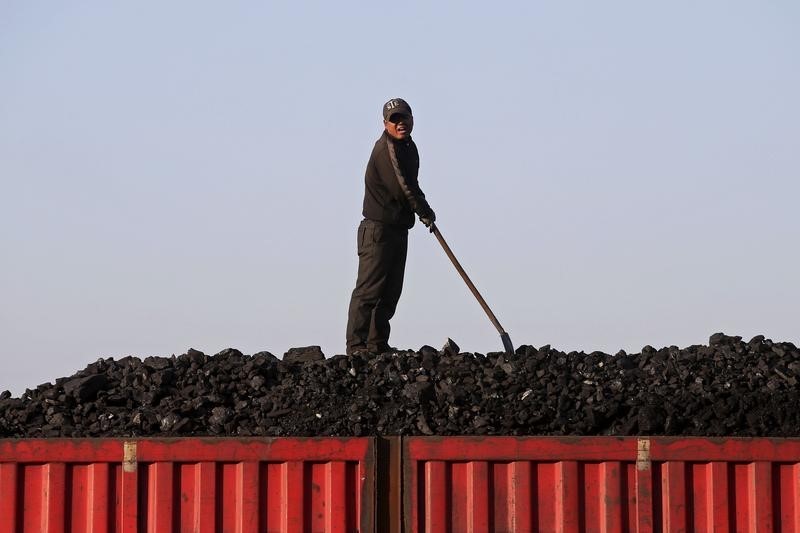(The opinions expressed here are those of the author, a columnist for Reuters)
* Coal rally driven by largely unexpected Chinese demand
* China's unpredictability leaves coal exporters wary
* Higher Chinese output would feed through in 6-9 months
* China coal futures graphic: http://tmsnrt.rs/2ebqQTL
By Clyde Russell
LISBON, Oct 19 (Reuters) - - The problem with coal's spectacular rally this year is that it's largely a Chinese political phenomenon, and what Chinese politicians give they can just as easily take away.
Australian thermal coal spot cargoes at Newcastle port for November GCLNWCPFBMc2 this week breached $100 a tonne for the first time in 4-1/2 years, closing on Tuesday at $102.20 and taking this year's rally to almost 120 percent.
There was much head-scratching this week at the annual World Coal Leaders conference in Lisbon over how virtually every analyst worldwide had misread the Chinese market, where imports have surged to 180.18 million tonnes in the first nine months of the year, up 15.2 percent from the same period of 2015.
The majority of analysts had expected China -- the world's biggest coal producer, consumer and importer -- to import less of the fuel in 2016 because of a slowing domestic economy and an official push to limit use of more polluting energy sources.
What caught most analysts off guard was the reduction in working days for Chinese coal mines to 274 days a year from 330 in an effort to cut output and thereby raise prices and profitability for domestic miners.
This was a blunt measure that appears to have been enforced rather than talked about and largely ignored, as is sometimes the case in China and happened this year in steel markets, where actual capacity cuts have fallen well short of what was planned.
Ultimately, the Chinese coal and steel sectors underscore the difficulty in accurately predicting what is likely to happen in the world's commodity epicentre.
In general terms, the mainly Western analyst community believed that steel capacity would be cut, most likely because there was a firm number to go along with the policy. But they remained sceptical about coal, given the absence of a numerical target.
What the market ended up with was Chinese domestic coal output down 10.5 percent year on year to 2.46 billion tonnes in the nine months to Sept. 30, while steel production gained 0.4 percent over the same period. means that Chinese domestic coal output is down about 300 million tonnes in the first three quarters -- a drop that is far larger than the reduction in demand from weaker thermal power generation.
This has resulted in inventory levels falling sharply in China, with Shanghai Steelhome data SH-QHA-COALINV showing stocks at China's major coal port Qinhuangdao of 3.55 million tonnes at Oct. 17, up from recent lows but still less than half the 7.25 million tonnes at the same time last year.
SCEPTICAL MINERS
The lower output and falling inventories resulted in a draw on the seaborne market that exporters weren't positioned to take advantage of, given the parlous state of the industry after five years of declining prices.
Most mines in major regional exporters Australia and Indonesia were being run at capacity and on the smell of an oily rag as operators went into survival mode, paring costs to the bone and deferring capital spending and exploration.
This meant that when Chinese demand did arrive, it couldn't be met easily, thereby pushing up prices rapidly.
However, understanding what has happened is only half the battle in coal markets.
Producers attending the World Coal Leaders conference remain sceptical that the rally is sustainable for the longer term, even if they expect prices to remain biased higher for the next six months or so.
The thinking is that the Chinese will continue to backtrack from capacity cuts and allow domestic miners to ramp up output to rebuild inventories and prevent prices from going too high.
This will take several months to flow through the system, meaning that the good times for exporting miners will last a while yet.
But it will take a very brave producer to invest in expanding output on the back of renewed hopes for sustained Chinese import growth.
As the old saying goes, once bitten, twice shy. Miners are still reeling from the massive expansion from 2010, which left the seaborne market structurally oversupplied when Chinese demand fell short of some extremely bullish forecasts.
The Beijing authorities aren't exactly renowned for telegraphing their intentions, but it would be reasonable to assume that they desire a domestic coal price high enough to keep miners profitable, and thus able to service debts, but not so high as to boost power prices by enough to have a negative effect on growth and inflation.
Where that price level lies is open to debate, but if it's around 500 yuan ($74.29) a tonne, it implies downside from the current Qinhuangdao price of 580 yuan, and therefore a lower price for seaborne coal as well.
This means that while thermal coal may well rise in the short term, it would most likely be biased lower on a six to nine-month view.
That is, of course, if Chinese authorities do what's expected of them. But as this year shows, that's far from guaranteed.
<^^^^^^^^^^^^^^^^^^^^^^^^^^^^^^^^^^^^^^^^^^^^^^^^^^^^^^^^^^^ Graphic of China coal futures forward curve:
http://tmsnrt.rs/2ebqQTL
^^^^^^^^^^^^^^^^^^^^^^^^^^^^^^^^^^^^^^^^^^^^^^^^^^^^^^^^^^^> (Editing by David Goodman)
